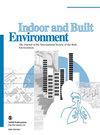Experimental studies on airborne transmission in hospitals: A systematic review
IF 2.9
3区 工程技术
Q2 CONSTRUCTION & BUILDING TECHNOLOGY
引用次数: 0
Abstract
Experimental studies can provide understanding, knowledge and real-case empirical evidence on the effects of building ventilation and environmental factors on airborne transmission in hospitals. Information obtained from existing studies gives insight into formulating engineering solutions and management practices to combat nosocomial airborne infections. A systemic review was conducted to summarize the experimental methods, research interests, useful results and limitations. With a steady but slow trend of increasing interest, experimental studies have been focusing mainly on the effects of ventilation systems, strategies and configurations on airborne transmission. The dispersion of bioaerosols under the combined effects of environmental factors, emission scenarios and human movement was investigated. Localized ventilation, air purifiers and disinfection technologies were also examined. The experimental techniques and some useful insights on optimal ventilation strategies and management practices were summarized and highlighted. Limitations of the empirical studies included sampling difficulties, limited scale and a number of testing scenarios, uncontrolled/unconsidered influencing factors and the media for experimentations. Using IoT-based sampling devices for experiments and real-time monitoring of bioaerosols or their surrogates, field surveys on a case-by-case basis in hospitals and interdisciplinary studies and collaborations could help overcome the research challenges and provide practical and effective solutions to minimize airborne transmission in hospitals.医院空气传播的实验研究:系统综述
实验研究可以为了解建筑通风和环境因素对医院空气传播的影响提供理解、知识和实际案例经验证据。从现有研究中获得的信息为制定工程解决方案和管理实践提供了见解,以对抗医院空气传播感染。本文对实验方法、研究方向、有用结果和局限性进行了系统综述。实验研究主要集中在通风系统、策略和配置对空气传播的影响上,研究兴趣稳步但缓慢地增加。研究了环境因素、排放情景和人类活动共同作用下生物气溶胶的扩散规律。局部通风、空气净化器和消毒技术也进行了研究。总结和强调了实验技术和一些关于最佳通风策略和管理实践的有用见解。实证研究的局限性包括取样困难、规模有限和测试场景众多、不受控制/未考虑的影响因素以及实验介质。使用基于物联网的采样设备进行实验和实时监测生物气溶胶或其替代品,在医院进行逐例实地调查以及跨学科研究和合作,可以帮助克服研究挑战,并提供实际有效的解决方案,以最大限度地减少医院的空气传播。
本文章由计算机程序翻译,如有差异,请以英文原文为准。
求助全文
约1分钟内获得全文
求助全文
来源期刊

Indoor and Built Environment
环境科学-工程:环境
CiteScore
6.40
自引率
25.00%
发文量
130
审稿时长
2.6 months
期刊介绍:
Indoor and Built Environment publishes reports on any topic pertaining to the quality of the indoor and built environment, and how these might effect the health, performance, efficiency and comfort of persons living or working there. Topics range from urban infrastructure, design of buildings, and materials used to laboratory studies including building airflow simulations and health effects. This journal is a member of the Committee on Publication Ethics (COPE).
 求助内容:
求助内容: 应助结果提醒方式:
应助结果提醒方式:


